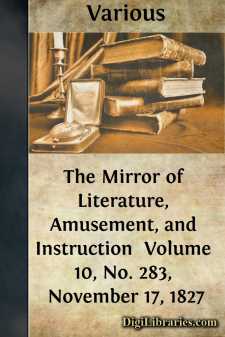Categories
- Antiques & Collectibles 13
- Architecture 36
- Art 48
- Bibles 22
- Biography & Autobiography 813
- Body, Mind & Spirit 142
- Business & Economics 28
- Children's Books 14
- Children's Fiction 11
- Computers 4
- Cooking 94
- Crafts & Hobbies 4
- Drama 346
- Education 46
- Family & Relationships 57
- Fiction 11829
- Games 19
- Gardening 17
- Health & Fitness 34
- History 1377
- House & Home 1
- Humor 147
- Juvenile Fiction 1873
- Juvenile Nonfiction 202
- Language Arts & Disciplines 88
- Law 16
- Literary Collections 686
- Literary Criticism 179
- Mathematics 13
- Medical 41
- Music 40
- Nature 179
- Non-Classifiable 1768
- Performing Arts 7
- Periodicals 1453
- Philosophy 64
- Photography 2
- Poetry 896
- Political Science 203
- Psychology 42
- Reference 154
- Religion 513
- Science 126
- Self-Help 84
- Social Science 81
- Sports & Recreation 34
- Study Aids 3
- Technology & Engineering 59
- Transportation 23
- Travel 463
- True Crime 29
The Mirror of Literature, Amusement, and Instruction Volume 10, No. 283, November 17, 1827
by: Various
Categories:
Description:
Excerpt
HADDON HALL.
The locomotive facility with which the aid of our graphic department enables us to transport our readers, (for we have already sent them to Sydney,) is somewhat singular, not to say ludicrous; and would baffle the wand of Trismegistus, or the cap of Fortunatus himself. Thus, during the last six weeks we have journeyed from the Palace at Stockholm (No. 277) to that of Buckingham, in St. James's Park, (278;) thence to Brambletye, in the wilds of Sussex, (279;) to Hamlet's Garden at Elsineur, (280;) then to the deserts of Africa, and Canterbury, (281;) in our last, (282,) we introduced our readers to the palatial splendour of the Regent's Park; and our present visit is to Haddon Hall, in Derbyshire, one of the palaces of olden time, whose stupendous towers present a strong contrast with the puny palace-building of later days, and the picturesque beauty of whose domain pleasingly alternates with the verdant pride of the Regent's Park.
Haddon is situate about one mile south-east of Bakewell, and is one of the most curious and perfect of the old castellated mansions of this country. It stands on a gentle hill, in the midst of thick woods overhanging the Wye, which winds along the valley at a great depth beneath. The house consists of two courts; in the centre building behind which is the great hall, with its butteries and cellars. Over the door of the great porch, leading to the hall, are two coats of arms cut in stone; the one is those of Vernon, the other of Fulco de Pembridge, lord of Tong, in Shropshire, whose daughter and heir married Sir Richard Vernon, and brought him a great estate. In one corner of the hall is a staircase, formed of large blocks of stone, leading to the gallery, about 110 feet in length and 17 in width, the floor of which is said to have been laid with boards cut out of one oak, which grew in the park. In different windows are the arms of England in the garter, surmounted with a crown; and those of Rutland impaling Vernon with its quarterings in the garter; and these of Shrewsbury. In the east window of the Chanel adjoining were portraits of many of the Vernon family, but a few years ago the heads were stolen from them. A date of Mi esimo ccccxxvii. is legible. In the north window the name Edwardus Vernon and his arms remain; and in a south window is Willmus Trussel. In the chapel also stands a Roman altar, dug up near Bakewell.
All the rooms (except the gallery) were hung with loose arras, a great part of which still remains; and the doors were concealed every where behind the hangings, so that the tapestry was to be lifted up to pass in or out. The doors being thus concealed, are of ill-fashioned workmanship; and wooden bolts, rude bars, &c. are their only fastenings. Indeed, most of the rooms are dark and uncomfortable; yet this place was for ages the seat of magnificence and hospitality. It was at length quitted by its owners, the Dukes of Rutland, for the more splendid castle of Belvoir, in Lincolnshire.
For many generations Haddon was the seat of the Vernons, of whom Sir George, the last heir male, who lived in the time of queen Elizabeth, gained the title of king of the Peak, by his generosity and noble manner of living....












